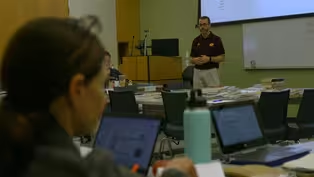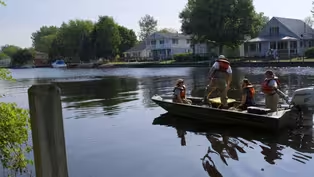Pressing Matters
Water Quality
Clip: Season 1 Episode 1 | 8m 41sVideo has Closed Captions
Water Quality and PFAS in Michigan's water ways.
Water Quality and PFAS in Michigan's water ways.
Problems playing video? | Closed Captioning Feedback
Problems playing video? | Closed Captioning Feedback
Pressing Matters is a local public television program presented by WCMU
Pressing Matters
Water Quality
Clip: Season 1 Episode 1 | 8m 41sVideo has Closed Captions
Water Quality and PFAS in Michigan's water ways.
Problems playing video? | Closed Captioning Feedback
How to Watch Pressing Matters
Pressing Matters is available to stream on pbs.org and the free PBS App, available on iPhone, Apple TV, Android TV, Android smartphones, Amazon Fire TV, Amazon Fire Tablet, Roku, Samsung Smart TV, and Vizio.
Providing Support for PBS.org
Learn Moreabout PBS online sponsorshipmeaning human made soap sort of thing.
So it's a degreaser.
It's coming off your clothing, it's coming off your rain gear, your carpets, you name it.
These chemicals are really good at what they were designed to do.
The problem is they get into the environment.
If we test that water right there, it'll have some concentration of PFAS in there.
- [Stefanie] You can't see them or even really feel them.
They're tasteless, but they're in the food we eat, the water we drink, and in the air we breathe.
These toxic chemicals, including per and polyol substances, also known as PFAS, make their way into our water and soil through products like insecticides and are used in industrial and consumer items like non-stick dishes and things like waterproofing sprays.
While they've been around since the 1950s, it wasn't until early two thousands that concerns rose when PFAS began showing up in people's blood work.
- Yeah, I mean, that's quite recent.
It's still happening right now.
That's kind of the more concerning part is that what we don't know about that, and we're learning and we're trying to learn as quickly as we can.
At this point, it's brand new.
Mercury is huge, of course, DDT, PCBs and PFAS and PFOS up and coming, and those are kind of more concerning because we really don't know what they do.
- Good morning.
- [Stefanie] Don Uzarski is the director of Central Michigan University's Institute for Great Lakes Research and Biological Station on Beaver Island.
He leads the Great Lakes Coastal Wetland Monitoring Program for the US Environmental Protection Agency.
- We're basically sampling every coastal wetland in the base, and it's about 10 acres size and has a surface water connection to the Great Lakes.
So part of that study, it, you know, the expense is getting there and having the people on hand, but we could do other projects.
So we're doing this PFAS project where we're collecting zebra and quagga mussels.
And because each one of 'em, you know, these tiny little things filter a liter of water per day, there're really good indication of what is in that water.
So then we can take the tissue of those zebra and quagga mussels and measure PFAS in those.
And we're seeing a relationship with agriculture, of all things.
So the percent agriculture adjacent to the wetland is a good indicator of how much PFAS we'll find out.
But be careful, don't think cause and effect don't, you know, a correlation is not causation.
It is basically a relationship.
So we don't quite understand what that relation, why that is at this point.
But what we're doing is we're using that as a tracer of anthropogenic disturbance or human disturbance, human impacts to the ecosystem.
Because if we know it can only come from humans, it's manmade, right?
So when we detect that, we know that there are other contaminants there as well.
And it's just a sort of an indicator of all the disturbances that take place.
- [Stefanie] Identifying contaminated bodies of water in land sites requires a multi-agency effort.
In recent years, the state has seen a significant increase of these areas.
It's an issue not unique to Michigan, but one the state says it's taking very seriously.
- We're out here collecting fish for the fish Contaminant monitoring Program, FCMP.
The site here is the Pine River.
We're gonna be collecting bottom feeding species like carp and suckers 'cause this is a DDT impacted site.
DDT was a pesticide that was banned several decades ago.
It still shows up in fish.
So we're just out here looking at trends.
And then we're also going to be collecting fish for the Michigan Department of Health and Human Services, MDHHS's Eat Safe Fish Program.
Everything we collect today will be tested for chemicals that build up to high levels in fish tissue.
So things like mercury, PCBs, DDT and PFOS, and as well as other PFAS.
- [Stefanie] This is the Pine River in St. Louis, home of one of the worst chemical poisonings in US history.
50 years ago, a distribution mixup here, sent flame retardant into the state food supply.
Eating fish from here is not allowed.
Crews with Michigan's Department of Environment, Great Lakes and Energy, or EGLE monitor water quality here, along with many bodies of water throughout the state.
They do so by testing the fish.
In order to catch them, the boat sends an electrical current into the water temporarily shocking the fish so they can be netted and carried on board.
- There's two goals for the FCMP Fish Contaminant Monitoring Program.
The first is to collect data that can be used by the Health department to issue those advisories.
So when we collect fish for that to meet that goal, we're only looking at the filet, the edible portion, just the portion of the fish that people are eating.
The second goal is to look at trends of contaminants over time and across the state.
So for those, for that program, we look at whole fish.
It's important to note that when we do test an entire fish, that data will not be used by the Health Department to issue those advisories.
- [Stefanie] Based on findings The Department of Health and Human Services can issue warnings, closures in advisories.
Now, it's important to reiterate that all parts of the fish are tested, including the filet.
Also, not all chemicals and contaminants build up equally in different types of fish.
- PFAS is a big thing with the state.
We do have a surface water monitoring program for PFAS.
That program's run by one of our toxicologists here at EGLE and they get to about four to five watersheds across the state every year.
So if they get a hit for PFOS, that's exceeds our water quality value, we would like to follow up the following year with, you know, fish contaminant monitoring.
10 years ago, we really didn't have a good grasp on, you know, how these chemicals were building up in fish tissue.
And so prior to us understanding, you know, we were looking at things like mercury that build up at higher concentrations in the, you know, higher trophic level fish, fish that are eating at the top of the food chain.
Things like walleye, lake trout.
- [Stefanie] Testing for specific contaminants requires specific testing conditions.
While CMU collects various water samples for certain contaminants in their labs, chemicals in the PFAS categories are sent to a dedicated lab out of state to be tested.
Understanding the contaminates polluting our waterways is critically important, especially because the Great Lakes are the largest fresh water system in the world.
- We're surrounded by water, we have wealth of water, and other states and countries don't.
And it's easy to take that for granted.
The more you have of a natural resource, the more you, you know, don't watch it.
But I think Michigan's really good at doing it, saying, no, wait a minute, we're gonna take care of this.
And that's what you're seeing.
And that's why we detect it everywhere, because we're looking and we're paying attention to it.
And when we do see a hot spot, we're trying to clean it up.
And we're trying to get those levels down to, you know, it's I hate to say acceptable concentrations of toxicants because there is no acceptable, but we reduce the danger and we set those limits at this is a low danger.
But you're gonna find the toxicants everywhere.
- Under the State's Safe Drinking Water Act, it lists what it considers safe limits for various contaminants.
According to WCMU, public radio guidelines for PFAS levels are reviewed routinely by the Department of Health and Human Services.
But because these forever chemicals are so new, there really are no known safe limits as researchers are still learning about them and their impact on people and the environment.
Artificial Intelligence in the Classroom
Video has Closed Captions
Clip: S1 Ep1 | 6m 55s | Artificial Intelligence in the Classroom (6m 55s)
Video has Closed Captions
Clip: S1 Ep1 | 9m 20s | Exploring microplastics in our water (9m 20s)
Providing Support for PBS.org
Learn Moreabout PBS online sponsorship
- News and Public Affairs

Top journalists deliver compelling original analysis of the hour's headlines.

- News and Public Affairs

FRONTLINE is investigative journalism that questions, explains and changes our world.












Support for PBS provided by:
Pressing Matters is a local public television program presented by WCMU

